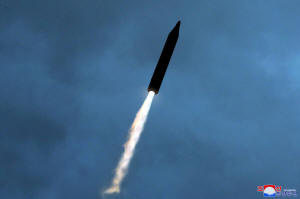N.Korea says missile tests simulate striking South with nuclear weapons
 Send a link to a friend
Send a link to a friend
 [October 10, 2022]
By Cynthia Kim and Josh Smith [October 10, 2022]
By Cynthia Kim and Josh Smith
SEOUL (Reuters) - North Korea's recent flurry of missile tests were
designed to simulate showering the South with tactical nuclear weapons
as a warning after large-scale navy drills by South Korean and U.S.
forces, state news agency KCNA said on Monday.
North Korea fired two ballistic missiles early on Sunday, officials in
Seoul and Tokyo said, the seventh such launch since Sept. 25.
Leader Kim Jong Un guided exercises by nuclear tactical units over the
past two weeks, involving ballistic missiles with mock nuclear warheads,
KCNA reported, saying they were meant to deliver a strong message of war
deterrence.
The tests simulated striking military command facilities, main ports,
and airports in the South, KCNA added.
"The effectiveness and practical combat capability of our nuclear combat
force were fully demonstrated as it stands completely ready to hit and
destroy targets at any time from any location," KCNA said.

"Even though the enemy continues to talk about dialogue and
negotiations, we do not have anything to talk about nor do we feel the
need to do so," KCNA quoted Kim as saying.
KCNA said North Korea's ruling Workers' Party decided to conduct the
drills as an unavoidable response to a large-scale mobilisation of U.S.
and South Korean naval forces, including an aircraft carrier and a
nuclear-powered submarine.
"The statement they've released is crystal clear that this recent spate
of tests was their way of signalling resolve to the United States and
South Korea as they carried out military activities of their own," said
Ankit Panda of the U.S.-based Carnegie Endowment for International
Peace.
The United States and South Korea held joint maritime exercises
involving a U.S. aircraft carrier on Friday, a day after the South
scrambled fighter jets in reaction to an apparent North Korean aerial
bombing drill.
The navy exercises involved the U.S. carrier Ronald Reagan and its
strike group. The naval forces of South Korea, Japan and the United
States also conducted joint drills before that.
After the North Korea statement on Monday, South Korean President Yoon
Suk-yeol's office said "it is important to accurately recognise the
severity of security issues in the Korean Peninsula and Northeast Asia
to prepare properly," an official was quoted as saying.
Japanese Prime Minister Fumio Kishida separately condemned Pyongyang's
recent missile launches and vowed to work toward "the complete
denuclearisation of North Korea in accordance with the U.N. Security
Council resolutions."
"This series of ballistic missile (launches) and these various
provocative acts are in clear violation of the U.N. Security Council
resolutions and are absolutely unacceptable," Kishida told reporters
when asked to comment on Monday's statement.
The U.S.-led UN forces are still technically at war with North Korea as
the 1950-1953 Korean War ended in an armistice rather than a peace
treaty.
[to top of second column]
|

A missile launch is seen at an
undisclosed location in North Korea, in this undated photo released
on October 10, 2022 by North Korea's Korean Central News Agency (KCNA).
KCNA via REUTERS

TACTICAL NUCLEAR WEAPONS
North Korea had only referred to one missile as having a tactical
nuclear capability, but the statement clarifies that many systems,
new and old, will be assigned such a role, Panda said.
If North Korea resumes nuclear testing, it could include development
of smaller “tactical” warheads meant for battlefield use and
designed to fit on short-range missiles such as the ones tested
recently, analysts said.
South Korean and U.S. officials say there are signs North Korea
could soon detonate a new nuclear device in underground tunnels at
its Punggye-ri Nuclear Test site, which was officially shuttered in
2018.
Analysts say putting small warheads on short-range missiles could
represent a dangerous change in the way North Korea deploys and
plans to use nuclear weapons.
NEW MISSILE, UNDERWATER SILOS
On Oct. 4, the North test-fired a ballistic missile farther than
ever before, flying what it said was a new intermediate-range
ballistic missile (IRBM) missile over Japan for the first time since
2017.
Analysts confirmed the photos released by state media do show a
previously unseen IRBM.
"It's incredibly unusual, though, that they'd test a previously
untested missile for the first time over Japan; it suggest a
substantial degree of confidence in the engine," Panda said.
Among the other missiles shown in the photos were short-range
ballistic missiles (SRBMs) that included KN-25 and KN-23 types as
well as one with a heavy 2.5-ton payload, as well as a KN-09 300mm
Multiple Launch Rocket System (MLRS).
The photos notably showed a test of a "navalised" KN-23 designed to
be launched from a submarine. That missile was showcased in a test
in the ocean last year, but this time the test was conducted in a
way that simulated a launch from what state media called "a silo
under a reservoir."
This year has seen North Korea test fire missiles from different
locations and launch platforms, including trains, in what analysts
say is an effort to simulate a conflict and make it difficult for
enemies to detect and destroy the missiles.

The KN-23 is designed to perform a “pull-up” manoeuvre as it
approaches a target, intended to help it evade missile defenses.
(Reporting by Cynthia Kim and Jack Kim; Additional reporting by
Kantaro Komiya; Editing by Cynthia Osterman, Aurora Ellis, Lincoln
Feast and Gerry Doyle)
[© 2022 Thomson Reuters. All rights
reserved.]
This material may not be published,
broadcast, rewritten or redistributed.
Thompson Reuters is solely responsible for this content. |